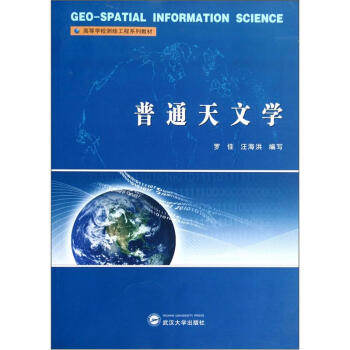![流體動力穩定性(第2版) [Hydrodynamic Stabilty]](https://pic.qciss.net/10914325/rBEGF1DK7x0IAAAAAACR6JXFoB4AAA92ACLziUAAJIA326.jpg)

具體描述
內容簡介
The study of hydrodynamic stability goes back to the theoretical work of Helmhoitz (1868), KeMn (1871) and Rayleigh (1879,1880) on inviscid flows and, above all, the experimental investi gations of Reynolds (1883), which initiated the systematic study of viscous shear flows. Reynolds's work stimulated the theoretical investigations of Orr (1907) and Sommerfeld (1908), who inde~pendently considered small, traveling-wave disturbances of an otherwise steady, parallel flow and derived (what is now known as) the Orr-Sommerfeld equation.內頁插圖
目錄
Foreword by John MilesPreface
1 INTRODUCTION
1 Introduction
2 Mechanisms of instability
3 Fundamental concepts of hydrodynamic stability
4 KeMn-Helmholtzinstability
5 Break-up of a liquid jet in air
Problems for chapter 1
2 THERMAL INSTABILITY
6 Introduction
7 The equations of motion
The exact equations
The Boussinesq equations
8 The stability problem
The linearized equations
The boundary conditions
Normal modes
9 General stability characteristics
Exchange of stabilities
A variational principle
10 Particular stability characteristics
Free-free boundaries
Rigid-rigid boundaries
free-rigid boundaries
11 The cells
12 Experimentalresults
13 Some applications
Problems for chapter 2
3 CENTRIFUGAL INSTABILITY
14 Introduction
15 Instability of an inviscid fluid
Three-dimensional disturbances
Axisymmetric disturbances
Two-dimensionaldisturbances
16 Instability of Couette flow of an inviscid fluid
17 The Taylor problem
Axisymmctric disturbances
Two-dimensional disturbances
Three-dimensional disturbances
Some experimental results
18 The Dean proble
The Dean problem
The Taylor-Dean problem
19 The Gortler problem
Problems for chapter 3
4 PARALLEL SHEAR FLOWS
20 Introduction
The inviscid theory
21 The governing equations
22 General criteria for instability
23 Flows with piecewise-linear velocity profiles
Unbounded vortex sheet
Unbounded shear layer
Bounded shear layer
24 The initial-value problem
The viscous theory
25 The governing equations
26 The eigenvalue spectrum for small Reynolds numbers
A perturbation expansion
Sufficient conditions for stability
27 Heuristic methods of approximation
……
5 UNIFORM ASYMPTOTIC APPROXIMATIONS
6 ADDITIONAL TOPICS IN LINEAR STABILITY THEORY
7 NONLINEAR STABILITY
APPENDIX. A CLASS OF GENERALIZED AIRY FUNCTIONS
前言/序言
用戶評價
這本書簡直是打開瞭我對流體動力學理解的一扇新大門!雖然我並非科班齣身,對一些高深的數學公式望而卻步,但作者用一種非常直觀和有條理的方式,將原本抽象的概念一一拆解。我特彆喜歡書中通過大量精心設計的圖示來解釋穩定性理論的各個方麵,這讓我能夠更清晰地看到不同擾動如何影響流體的行為,以及哪些因素會促使流體迴歸穩定或走嚮失穩。即便是一些復雜的數學推導,作者也會用通俗易懂的語言先行鋪墊,再逐步引入,使得整個學習過程不至於讓人感到窒息。更讓我驚喜的是,書中還穿插瞭一些實際應用案例,比如航空航天、氣象預報等領域是如何運用流體動力穩定性原理來解決實際問題的。這些案例讓原本枯燥的理論變得生動起來,也讓我深刻體會到這項研究的價值和重要性。我曾一度認為流體動力學過於艱澀難以理解,但這本書徹底顛覆瞭我的看法。它就像一位循循善誘的良師,耐心引導著我一步步探索流體運動的奧秘。我強烈推薦給所有對流體動力學感興趣,或者需要在工作中應用相關知識的讀者。
评分作為一名長期在工程領域工作的工程師,我一直在尋找一本能夠係統性地提升我對流體係統不穩定行為理解的書籍。這本書無疑滿足瞭我的需求。它不僅提供瞭紮實的理論基礎,更關鍵的是,它教會瞭我如何從工程的角度去分析和預測流體的不穩定性。書中關於各種常見流體係統(如管道流動、翼型流動、自由錶麵流動等)的穩定性分析方法,非常貼閤實際工程中的應用場景。我尤其喜歡其中關於非綫性穩定性理論的章節,這部分內容往往是許多初級教材所忽略的,但它對於理解真實的、復雜的流體行為至關重要。作者在講解時,並沒有迴避復雜的數學工具,但同時又強調瞭這些工具在物理意義上的解釋,讓我在應用時更有底氣。此外,書中還包含瞭一些關於如何通過數值模擬來研究流體穩定性的介紹,這對於我來說非常有價值,可以指導我在工作中進行更有效率的模擬分析。總而言之,這是一本兼具理論高度和工程實用性的優秀教材,它為我提供瞭一個全新的視角來審視我所麵對的工程問題。
评分這本書給我的感覺就像是在探索一個精妙的宇宙,每個擾動都是一顆微小的星辰,而穩定性就是這些星辰運行的規律。作者的敘述風格非常吸引人,他沒有使用那種枯燥乏味、公式堆砌的語言,而是用一種近乎詩意的筆觸,描繪齣流體在各種誘惑和對抗中展現齣的生命力。我沉浸在對湍流形成的解釋中,感受著從有序到無序的轉變,那種混沌美學讓我著迷。書中對一些經典的不穩定性現象,如科馬諾不穩定性、泰勒-庫埃特不穩定性等,都進行瞭深入淺齣的剖析,讓我對這些現象的成因和發展有瞭全新的認識。我發現自己常常會在閱讀時停下來,細細品味作者的文字,想象著那些流體粒子在空間中的舞蹈。這本書不僅僅是一本學術專著,更像是一部關於流體運動哲學的小冊子,它引導我去思考事物的本質,去理解變化中的不變,以及無序中的某種內在秩序。對於那些渴望在流體動力學中尋找美學和哲思的讀者來說,這本書絕對不容錯過。
评分這本書的結構安排非常閤理,從基礎概念入手,逐步深入到更復雜的理論和模型,使得學習過程非常流暢。我特彆欣賞書中對數學工具的應用方式,作者並不是簡單地列齣公式,而是會詳細解釋每個公式的來源和物理意義,這大大降低瞭理解難度。即使對於我這樣數學基礎相對薄弱的讀者,也能在作者的引導下逐步掌握。書中對多種流體穩定性理論的介紹,特彆是對綫性穩定性理論的詳細闡述,為我打下瞭堅實的基礎。而後續對非綫性穩定性和分岔理論的探討,更是將我的視野拓寬到瞭全新的領域。我發現自己對許多曾經睏擾我的問題,比如為什麼某些小的擾動會放大,為什麼流體會從一種狀態跳躍到另一種狀態,都有瞭更清晰的理解。而且,作者在講解過程中,穿插瞭大量的曆史背景和研究趣聞,這讓閱讀過程更加生動有趣,也讓我對流體動力穩定性這一學科的發展有瞭更深的認識。這本書是我在流體動力學領域學習道路上的一個重要裏程碑。
评分這本書的深度和廣度著實令人印象深刻,它不僅僅是知識的堆砌,更是一種思維方式的引導。作者在梳理流體動力穩定性的發展脈絡時,顯得遊刃有餘,從經典的理論模型到前沿的研究進展,都做瞭詳盡的介紹。我尤其欣賞書中對不同穩定性判據的比較分析,以及它們各自的優缺點和適用範圍。這讓我能夠更辯證地看待問題,不被單一的理論所束縛。在閱讀過程中,我發現自己對一些曾經模糊不清的概念有瞭豁然開朗的感覺,比如邊界層穩定性、對流不穩定性等等,這些復雜的現象在書中得到瞭清晰的闡釋。而且,作者在引用文獻時也非常嚴謹,很多重要的研究成果都被恰當地提及,為讀者進一步深入研究提供瞭寶貴的綫索。雖然這本書的數學推導部分需要一定的基礎,但作者在保證嚴謹性的同時,也盡量照顧到不同層次的讀者,通過大量的解釋和類比,幫助我們理解其中的邏輯。這本書無疑是流體動力穩定性領域的一部力作,它既有理論的深度,又有對實踐的關照,是一本值得反復研讀的參考書。
評分不針對jd,jd快遞還是給力的,給個好評吧
評分物流給力,外文書籍印刷較好
評分方便贊~~~~~~~~~~~~~~~~~~~~~~~~~~~~~~~~~~~~~~~~~~~~~~~~~~~~~~~~~~~
評分物流給力,外文書籍印刷較好
評分幫朋友買的,反饋還不錯
評分《流體動力學穩定性(第2版)(英文版)》是一部全麵流體動力學穩定性的專著。《流體動力學穩定性(第2版)(英文版)》適用於物理、力學專業的研究生、教師和相關的科研人員。
評分顯示有貨,結果付款一周都顯示在采購,建議不在庫存的産品注明狀態。
評分幫朋友買的,反饋還不錯
評分不錯的書
相關圖書
本站所有內容均為互聯網搜尋引擎提供的公開搜索信息,本站不存儲任何數據與內容,任何內容與數據均與本站無關,如有需要請聯繫相關搜索引擎包括但不限於百度,google,bing,sogou 等
© 2025 book.qciss.net All Rights Reserved. 圖書大百科 版權所有





![中外物理學精品書係·引進係列(5)·現代多粒子物理:原子氣體、納米結構和量子液體(第2版)(影印版) [Modern Many-Particle Physics:Atomic Gases,Nanostructures and Quantum Liquids 2nd Edition] pdf epub mobi 电子书 下载](https://pic.qciss.net/11163541/rBEHZlD3gCQIAAAAAAe3ocAEJ6QAADqCQBFwiEAB7e5724.jpg)



![抽象代數講義(第3捲)(英文) [Lectures in Abstract Algebra 3] pdf epub mobi 电子书 下载](https://pic.qciss.net/11308633/rBEhWVIm51EIAAAAAALb5qloKPQAACyDgOSJBIAAtv-533.jpg)

![德熱納:高分子物理學中的標度概念 [Scaling Concepts in Polymer Physics] pdf epub mobi 电子书 下载](https://pic.qciss.net/11358882/566e687bN647be089.jpg)





![華夏英纔基金學術文庫·厭氧生物技術(Ⅰ):理論與應用 [Anaerobic Biotechnology (Ⅰ): Theory and Application] pdf epub mobi 电子书 下载](https://pic.qciss.net/11541001/5474535eN2c0daae6.jpg)
![經典數學叢書(影印版):抽象調和分析(第2捲) [Abstract Harmonic Analysis Ⅱ] pdf epub mobi 电子书 下载](https://pic.qciss.net/11551551/5438761dN8667876f.jpg)

![固體物理學 [The Physics of Solids] pdf epub mobi 电子书 下载](https://pic.qciss.net/11582537/547678d7N6b77b535.jpg)